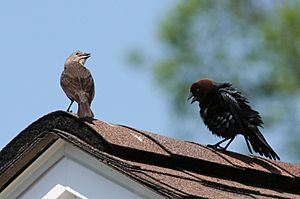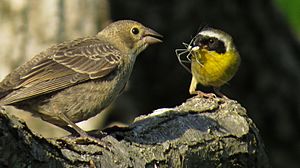Brown-headed cowbird facts for kids
Quick facts for kids Brown-headed cowbird |
|
|---|---|
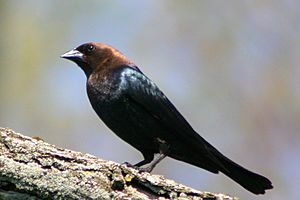 |
|
| Adult male | |
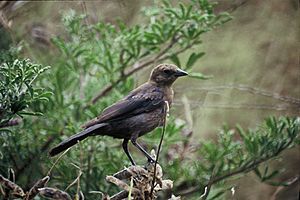 |
|
| Adult female | |
| Conservation status | |
| Scientific classification | |
| Genus: |
Molothrus
|
| Species: |
ater
|
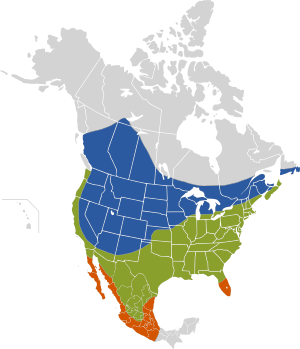 |
|
| Breeding range Year-round range Wintering range | |
The brown-headed cowbird (Molothrus ater) is a small obligate brood parasitic icterid native to temperate and subtropical North America. They are permanent residents in the southern parts of their range; northern birds migrate to the southern United States and Mexico in winter, returning to their summer habitat around March or April.
Contents
Taxonomy
The brown-headed cowbird was described by the French polymath Georges-Louis Leclerc, Comte de Buffon in 1775 in his Histoire Naturelle des Oiseaux from a specimen collected in the Carolinas. The bird was also illustrated in a hand-coloured plate engraved by François-Nicolas Martinet in the Planches Enluminées D'Histoire Naturelle which was produced under the supervision of Edme-Louis Daubenton to accompany Buffon's text. Neither the plate caption nor Buffon's description included a scientific name but in 1783 the Dutch naturalist Pieter Boddaert coined the binomial name Oriolus ater in his catalogue of the Planches Enluminées. The brown-headed cowbird is now placed in the genus Molothrus that was introduced by the English naturalist William Swainson in 1832 with the brown-headed cowbird as the type species. The genus name combines the Ancient Greek mōlos meaning "struggle" or "battle" with thrōskō meaning "to sire". The specific ater is Latin for "dull black". The English name "cowbird", first recorded in 1839, refers to this species often being seen near cattle.
Three subspecies are recognised:
- M. a. artemisiae Grinnell, 1909 – interior west Canada and west USA
- M. a. obscurus (Gmelin, JF, 1789) – coastal Alaska, Canada, USA and northwest Mexico
- M. a. ater (Boddaert, 1783) – southeast Canada, east and central USA and northeast Mexico
Description
The brown-headed cowbird is typical for an icterid in general shape, but is distinguished by a finch-like head and beak and its smaller size. The adult male is iridescent black in color with a brown head. The adult female is slightly smaller and is dull grey with a pale throat and very fine streaking on the underparts. The total length is 16–22 cm (6.3–8.7 in) and the average wingspan is 36 cm (14 in). Body mass can range from 30–60 g (1.1–2.1 oz), with females averaging 38.8 g (1.37 oz) against the males' average of 49 g (1.7 oz).
Distribution and habitat
The species lives in open or semiopen country, and often travels in flocks, sometimes mixed with red-winged blackbirds (particularly in spring) and bobolinks (particularly in fall), as well as common grackles or European starlings. These birds forage on the ground, often following grazing animals such as horses and cattle to catch insects stirred up by the larger animals. They mainly eat seeds and insects.
Before European settlement, the brown-headed cowbird followed bison herds across the prairies. Its population expanded with the clearing of forested areas and the introduction of new grazing animals by settlers across North America. Brown-headed cowbirds are now commonly seen at suburban birdfeeders.
Behavior and ecology
Breeding
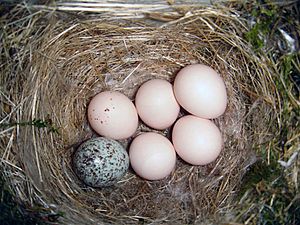
The brown-headed cowbird is an obligate brood parasite; it lays its eggs in the nests of other small passerines (perching birds), particularly those that build cup-like nests. The brown-headed cowbird eggs have been documented in nests of at least 220 host species, including hummingbirds and raptors. The young cowbird is fed by the host parents at the expense of their own young. Brown-headed cowbird females can lay 36 eggs in a season. More than 140 different species of birds are known to have raised young cowbirds.
Unlike the common cuckoo, the brown-headed cowbird is not divided into gentes whose eggs imitate those of a particular host.
Some host species, such as the house finch, feed their young a vegetarian diet. This is unsuitable for young brown-headed cowbirds, meaning almost none survive to fledge.
Male behavior and reproductive success
Social behaviors of cowbird males include aggressive, competitive singing bouts with other males and pair-bonding and monogamy with females.
By manipulating demographics so juveniles only had access to females, juvenile males developed atypical social behavior; they did not engage in the typical social singing bouts with other males and did not pair bond with females. This demonstrates that great flexibility occurs in the behavior of cowbirds, and that the social environment is extremely important in structuring their behavior. Adult males housed with juvenile males were shown to have greater reproductive success compared to adult males housed with other adult males. Being housed with juvenile males honed the reproductive skills of the adult males by providing them with a more complex social environment.
This finding was further studied by comparing the behaviors and reproductive success of males exposed to a dynamic flock, consisting of changing individuals, with males exposed to a static group of individuals. The individuals that stayed with the same group (i.e., static flock) had a stable, predictable relationship between social behavior and reproductive success; the males that sang frequently to females experienced the greatest reproductive success. The adult males that were exposed to a rotating roster of new individuals (i.e., dynamic flock) had an unpredictable relationship between social variables and reproductive success. The males that lived in static flocks had high levels of consistency in their behaviors and reproductive success across multiple years, whereas the males in dynamic flocks experienced varying levels of dominance with other males, differing levels of singing to females, and differing levels of reproductive success.
Brood parasitism
Brown-headed cowbirds do not raise their own young, instead they lay their eggs in the nests of other bird species. As a result, young cowbirds are not exposed to species-typical visual and auditory information like other birds. Despite this, cowbirds are able to develop species-typical singing, social, and breeding behaviors. A 2017 study demonstrated that cowbird brains are wired to respond to the vocalizations of other cowbirds, allowing young to find and join flocks of their own species. These vocalizations are consistent across all cowbird populations, and serve as a sort of species-recognition password. If a young cowbird is not exposed to these "password" vocalizations by a certain age, it will mistakenly imprint on the host species.
Relationship to humans
With the expansion of its range and its parasitic behavior, the brown-headed cowbird is often regarded as a pest. Americans sometimes engage in cowbird control programs, with the intention of protecting species negatively impacted by the cowbirds' brood parasitism. A study of nests of Bell's vireo highlighted a potential limitation of these control programs, demonstrating that removal of cowbirds from a site may create an unintended consequence of increasing cowbird productivity on that site, because with fewer cowbirds, fewer parasitized nests are deserted, resulting in greater nest success for cowbirds.
See also
 In Spanish: Tordo cabecicafé para niños
In Spanish: Tordo cabecicafé para niños



